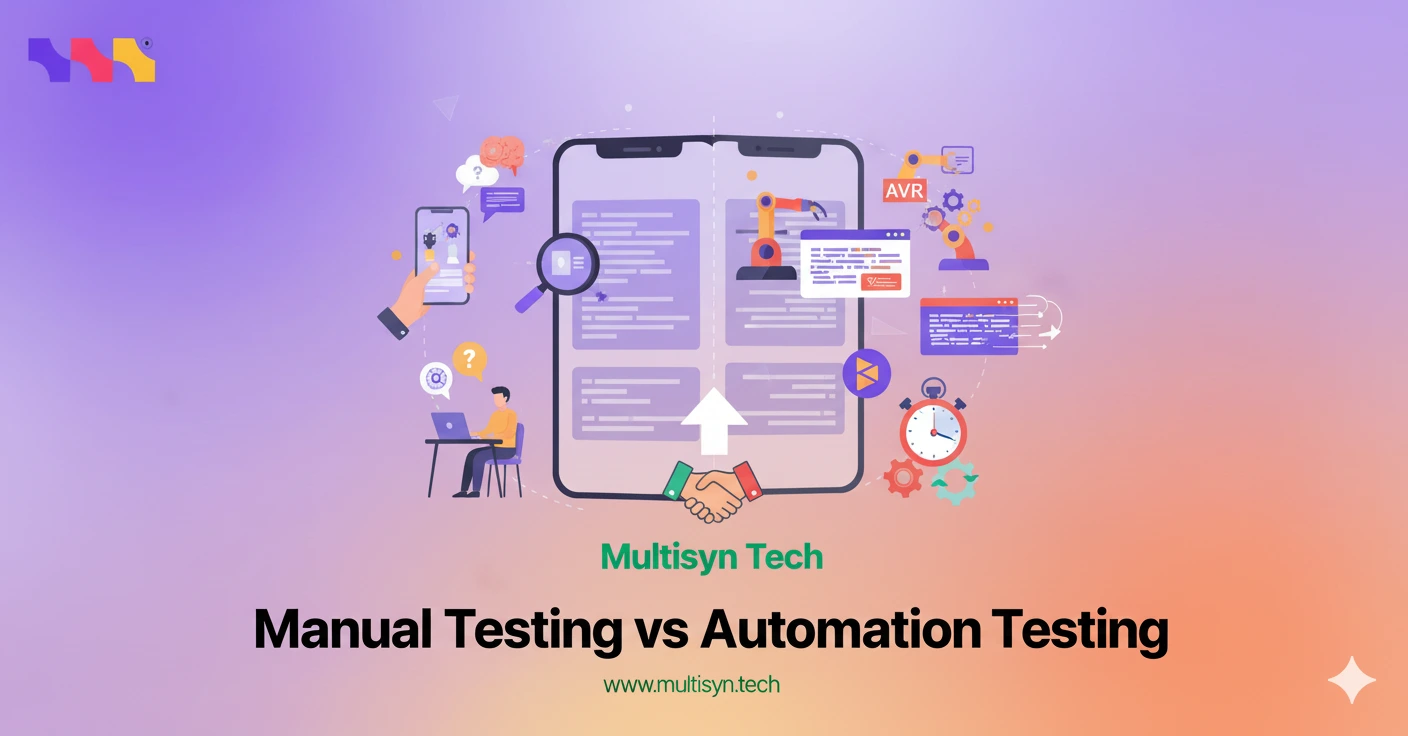There are two main types of methods used in the software testing world to guarantee application quality: manual and automated testing. They each have their strengths, and you need both at different times. Both have much in common, but also bring essential differences and advantages both of which Multisyn Tech can help you choose the best approach for your project.
What is Manual Testing?
The manual testing approach is a process where testers evaluate test cases manually without using automation tools. Human participants test the software by evaluating its features, functionality, and workflow as they see fit. While manual tests require more time and staff investment, they provide a better grasp of the theoretical user experience and ensure that the software serves a practical purpose.
For a detailed overview of different quality assurance types, check out our guide on types of quality assurance in software testing.
What is Automation Testing?
Automation testing is a type of software testing where an actual tester is not required to send inputs or execute outputs. Testers or developers write scripts to verify that the software works correctly. Once written, these scripts are repeatable, save time, and limit human error. Automation is highly valuable in repetitive and sequential testing especially in continuous integration scenarios.
You can explore our QA & Software Testing services to see how automation helps ensure flawless product performance.
Manual Testing vs Automation Testing: Key Differences
Time Consumption
Manual testing is time-consuming, as test cases are written and run manually. After automation scripts are written, automation testing becomes quick and repetitive, allowing you to run it on demand without effort.
Cost
Manual testing is often costly in terms of time and resources. Automated testing is expensive to build but saves money over the long run by expediting the testing process. Learn how QA-as-a-Service can optimize costs and enhance efficiency.
Reusability
Manual testing must be repeated for every new test cycle. Once automation scripts are written, they can be reused across projects and systems.
Human Involvement
Manual testing involves human execution and analysis. Automation testing, on the other hand, reduces human interference once the scripts are configured.
Best For
Manual testing suits smaller, ad-hoc, or user tests where human intuition is valuable.
Automation testing fits repetitive or regression testing and large-scale system validations.
Benefits of Manual Testing
- Human Insight: Ideal for exploratory testing that automation might miss.
- Flexibility: Works well for complex, ad-hoc scenarios.
- User Experience Focus: Testers experience the software first-hand, essential for UI/UX validation.
- Immediate Feedback: Offers instant insights into usability and user interaction.
To better understand manual testing’s role within QA strategies, visit our Quality Assurance Guide.
Benefits of Automation Testing
- Efficiency: Faster for repeatable tasks and large test cases.
- Reusability: Scripts can be reused across builds and versions.
- Accuracy: Eliminates human error and ensures consistent results.
- Scalability: Supports complex test cases easily.
- Cost-Effective Over Time: Though setup costs are high, automation reduces long-term expenses.
Automation is also crucial in improving your software’s reliability learn more in our article on boosting your software’s reliability.
How Multisyn Tech Helps You Choose the Right Testing Method
At Multisyn Tech’s Quality Assurance & Testing Services, we work with you to gain a clear understanding of your specific project requirements and assist in selecting the most suitable test process. Testing can be manual for smaller, user-centric projects or automated for heavy repetitive tasks our specialist team knows which route to take.
We consider factors such as project size, release frequency, and end-user experience to customize the right testing approach that aligns with your goals while keeping costs down.
Conclusion
Manual and automation testing both offer unique advantages. The right method depends on your project’s size, frequency, and goals. Smaller, user-focused tests benefit from manual methods, while large-scale or repetitive testing is better automated.
Let Multisyn Tech help you achieve the perfect balance ensuring quality, saving time, and accelerating your time-to-market.







